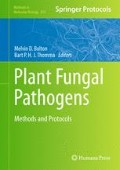Abstract
Targeted gene replacement is one of the primary strategies for functional characterization of fungal genes and several methods have been developed for this purpose over the years. The increased availability of genome sequence information in the present times has enabled wider adoption of protocols based on the knowledge of the gene sequence and its surrounding region. Among such targeted gene replacement approaches, the spilt-marker method has gained popularity in filamentous fungi. This method involves only two rounds of PCR and does not require any subcloning. It is based on the availability of a marker gene (e.g., the hygromycin gene) and sequences of the gene of interest, as well as around 1 kb long regions flanking the gene on either side. The technique includes PCR amplification of the flanking regions of the gene of interest and the marker gene followed by a fusion PCR which leads to the creation of two molecular cassettes, each containing a part of the marker gene fused to one flanking region. These molecular cassettes are then simultaneously used for transformation of protoplasts. Three homologous recombination events, one within each flanking region and one in the marker gene, lead to the replacement of the gene of interest with a functional marker gene. The transformants are then grown on selective media and emerging colonies can be screened for presence of the marker and absence of the gene being replaced using various methods.
Access this chapter
Tax calculation will be finalised at checkout
Purchases are for personal use only
References
Fairhead C et al (1996) New vectors for combinatorial deletions in yeast chromosomes and for gap-repair cloning using ‘split-marker’ recombination. Yeast 12: 1439–1457.
Fairhead C et al (1998) ‘Mass-murder’ of ORFs from three regions of chromosome XI from Saccharomyces cerevisiae. Gene 223: 33–46.
Catlett N et al (2003) Split-marker recombination for efficient targeted deletion of fungal genes. Fungal Genet. Newsl 50: 9–11.
Goswami RS et al (2006). Genomic analysis of host-pathogen inaction during early stages of disease development. Microbiology 152: 1877–1890.
Correll JC et al (1987) Nitrate nonutilizing mutants of Fusarium oxysporum and their use in vegetative compatibility tests. Phytopathology 77: 1640–1646.
Evans CK et al (2000) Biosynthesis of deoxynivalenol in spikelets of barley inoculated with macroconidia of Fusarium graminearum. Plant Dis 84: 654–660.
Gale LR et al (201) Nivalenol-type populations of Fusarium graminearum and F. asiaticum are prevalent on wheat in southern Louisiana. Phytopathology 101: 124–134.
Ho SN et al (1989) Site-directed mutagenesis by overlap extension using the polymerase chain reaction. Gene 77: 51–59.
Rosewich UL et al (1999) Population genetic analysis corroborates dispersal of Fusarium oxysporum f. sp. radicislycopersici from Florida to Europe. Phytopathology 89: 623–630.
Acknowledgments
I would like to thank Dr. H.C. Kistler in whose laboratory the protocol mentioned here was initially standardized for F. graminearum and members of his lab, particularly Karen Hilburn for her input in protocol development and manuscript preparation. Thanks are also due to Dr. Jin-Rong Xu for assisting with standardization of the method and providing additional information for the chapter.
Author information
Authors and Affiliations
Corresponding author
Editor information
Editors and Affiliations
Rights and permissions
Copyright information
© 2012 Springer Science+Business Media, LLC
About this protocol
Cite this protocol
Goswami, R.S. (2012). Targeted Gene Replacement in Fungi Using a Split-Marker Approach. In: Bolton, M., Thomma, B. (eds) Plant Fungal Pathogens. Methods in Molecular Biology, vol 835. Humana Press. https://doi.org/10.1007/978-1-61779-501-5_16
Download citation
DOI: https://doi.org/10.1007/978-1-61779-501-5_16
Published:
Publisher Name: Humana Press
Print ISBN: 978-1-61779-500-8
Online ISBN: 978-1-61779-501-5
eBook Packages: Springer Protocols

